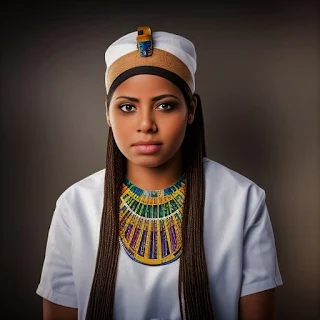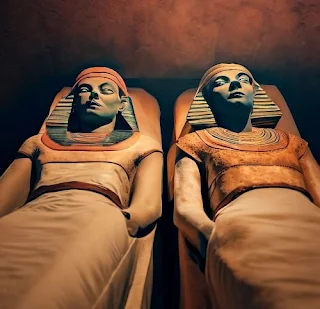Female Embalmers in Ancient Egypt
Women in ancient Egypt were essential for embalming; they had a crucial role in preparing the dead for the afterlife and were skilled and respected for their work.
In the realm of ancient Egypt, women held vital positions as embalmers, making significant contributions to the process of preserving the deceased. These skilled individuals took on the responsibility of cleansing, drying, and wrapping the mummified bodies, employing their expertise in the intricate rituals and techniques of mummification. Referred to as Hab, these female embalmers were highly respected for their specialized training and profound understanding of the sacred art of preserving the departed.
The involvement of women in the mummification process highlights their integral role in upholding the cultural and spiritual practices surrounding death in ancient Egypt. Their meticulous work ensured the proper preparation and preservation of the deceased, enabling their smooth transition into the afterlife. Furthermore, their expertise and dedication honored the departed, bridging the gap between the realms of the living and the dead.
Hab Are Female Embalmers Guiding and Caring for the Dead.
The term Hab used to refer to female embalmers in ancient Egypt is derived from the Egyptian language. The word Hab means pure or ritually clean in the Egyptian language. It was a title given to those who were trained and qualified in the art of embalming and mummification.
Hab was explicitly associated with female embalmers, distinguishing them from male embalmers or other individuals involved in mortuary practices. It denoted their expertise, adherence to ritual purity and essential role in mummification.
The ancient Egyptians placed great importance on ritual purity and believed those who handled the deceased should be spiritually clean. The title Hab reflected the high level of respect and recognition given to these skilled women who performed the sacred and vital task of preserving the bodies of the deceased for their eternal journey.
The role of the Hab was explicitly related to the practical and technical aspects of embalming and mummification. They were responsible for preparing and preserving the bodies of the deceased rather than holding priestly positions.
Rituals by women embalmers were necessary to preserve the body during the mummification process.
In ancient Egypt, the knowledge and techniques of mummification were passed down through generations. Hab was responsible for the meticulous process of preserving and preparing the deceased for the afterlife. The process involved a combination of apprenticeship, ritual purification, and specialized knowledge.
Embalming was considered a sacred ritual closely linked to the god Anubis, who presided over the realm of the deceased. To become skilled in mummification, embalmers underwent rigorous religious training and rituals. They were trained by experienced embalmers and worked under their supervision until they acquired the necessary skills.
The mummification process involved many rituals crucial for preserving the body and ensuring a smooth passage of the deceased into the afterlife. The patterns included purification, removal of organs, evisceration and drying, wrapping, opening the mouth, anointing, funerary rites, and offerings.
The body was purified and cleansed before the embalming process began. This involved washing the body with water from the Nile or unique cleansing solutions. Next, the embalmers would carefully remove the internal organs, except for the heart, as it was believed to be the seat of intelligence and would be needed in the afterlife. Finally, the organs were typically placed in canopic jars for preservation.
After removing the organs, the body cavity was cleansed and filled with aromatics, resins, and spices. The body was then left to dry for several weeks to remove moisture. Finally, the body was carefully wrapped in linen bandages. Sometimes, amulets or charms were placed between the layers of linen to offer protection and guidance in the afterlife.
This ritual involved touching the mouth of the deceased with various instruments and reciting spells to ensure that the dead could eat, drink, and breathe in the afterlife. The body was anointed with oils and resins to preserve and protect it. Fragrant substances, such as myrrh and frankincense, were commonly used.
Funerary rites and offerings were conducted to honor the deceased and provide for their needs in the afterlife. These included prayers, incense, food offerings, and symbolic rituals to invoke the gods' support. These rituals were performed by the embalmers or priests of Anubis with great reverence and adherence to tradition. They were seen as sacred acts, ensuring the proper preservation of the body and facilitating the deceased's journey into the realm of the gods.
Naturally Occurring Minerals, Oils, Tools, and Materials Used in the Mummification Process.
Natron is a naturally occurring mineral salt found in abundance in the deserts of Egypt. Natron was used as a drying agent and disinfectant during the embalming process. The Natron was also applied to the body's exterior, covering it entirely or in specific areas.
The Natron acted as a desiccant, drawing out moisture from the body and inhibiting bacterial growth. It effectively preserves the body's tissues by preventing decay and putrefaction. The body would typically be left in a bed of Natron for approximately 40 days to ensure thorough drying. After drying, the body was removed from the Natron and washed. Next, the body was covered and filled with Natron, which helped to dry out the tissues and prevent decomposition.
With its abundant salt lakes, the Wadi Natrun area in Egypt was the primary source of Natron for ancient Egyptians. The dry desert climate and these natural deposits made it an ideal location for obtaining Natron. The Egyptians used the Natron from this region extensively in their mummification practices, ensuring the preservation of the deceased for their journey to the afterlife.
Embalmers used hooked instruments to remove the brain through the nasal cavity and to extract the internal organs through a small incision in the left side of the body. The embalming hook tool had a hooked or barbed end and was used to extract the brain through the nasal cavity during brain removal.
Hooked probes were instruments with a hooked or curved end used to extract and manipulate internal organs during evisceration. For example, they were used to reach and remove the liver, lungs, intestines, and other organs.
The crook and flail were ceremonial symbols often depicted in the hands of pharaohs and were associated with their divine authority. While not explicitly used in the mummification process, they are sometimes associated with the topic due to their symbolic significance.
Canopic jars were special containers used to hold the preserved internal organs of the deceased. Each jar was associated with a specific deity and had a lid shaped like the head of the corresponding god or goddess.
Linen bandages played a crucial role in the mummification process of ancient Egypt. After the body had been cleansed, dried with Natron, and treated with various resins and oils, it was ready to be wrapped in linen bandages.
The purpose of the linen bandages was to provide support and protection and maintain the mummy's shape. The tight wrapping helped to secure the body and keep the limbs in place. Additionally, the linen bandages provided a symbolic and physical barrier between the preserved body and the external elements.
The mummy was often placed in a decorated wooden coffin or a stone sarcophagus, ensuring its protection and preservation. In addition, carefully wrapping the body with linen bandages was an integral part of the mummification process, helping safeguard the deceased individual for eternity.
Many resins and oils were used during mummification to anoint and preserve the body. These substances had religious and practical significance; Myrrh was a resin obtained from the sap of the Commiphora tree. It was a highly valued substance used in mummification. Myrrh was known for its antiseptic properties and ability to inhibit bacteria growth. It was used in the form of an oil or a paste.
Frankincense, derived from the resin of the Boswellia tree, was another vital substance in the mummification process. Like myrrh, it had antimicrobial properties. It was often burned as incense during the rituals and used as an oil or paste. The resin of pine trees was sometimes used in the mummification process. It was known for its preservative properties and was applied to the body to help prevent decay.
Cedar oil, extracted from the wood of the cedar tree, was used for its aromatic properties. It had a pleasant scent and was believed to have purifying qualities. Cedar oil was applied to the body to perfume and protect it. Palm oil was used to soften and moisturize the skin. After the Natron drying process, it was applied to the body to restore tissue flexibility and suppleness.
Ancient Egyptian Female Embalmers Were Well Educated and Walked Between the Realms of Life and Death.
Women in ancient Egypt played significant roles as embalmers, contributing to preserving and preparing mummified bodies. Skilled in mummification's intricate rituals and techniques, these female embalmers, known as Hab, held a revered position in ancient Egyptian society.
Their responsibilities encompassed the cleansing, drying, and wrapping the mummified body. Through their expertise, they upheld the traditions and rituals associated with death, serving as custodians of ancient wisdom and cultural practices. The title of Hab denoted their specialized training in the art of preserving the deceased.
By delving into these female embalmers' training, techniques, and beliefs, we gain insights into the profound reverence and timeless traditions surrounding their sacred role. Through their practices, they bridged the realms of life and death, honoring the departed and ensuring their successful journey into the afterlife.
The role of embalmers, including female embalmers, was highly respected in ancient Egyptian society. Mummification was complex and intricate, requiring extensive knowledge of anatomy, preservation techniques, and religious rituals.
Female embalmers demonstrated remarkable skill and expertise in these areas, earning the respect and admiration of their peers and the wider community. Furthermore, their ability to successfully preserve and prepare the deceased for the afterlife was crucial in ensuring the continuity of Egyptian cultural and religious practices.









